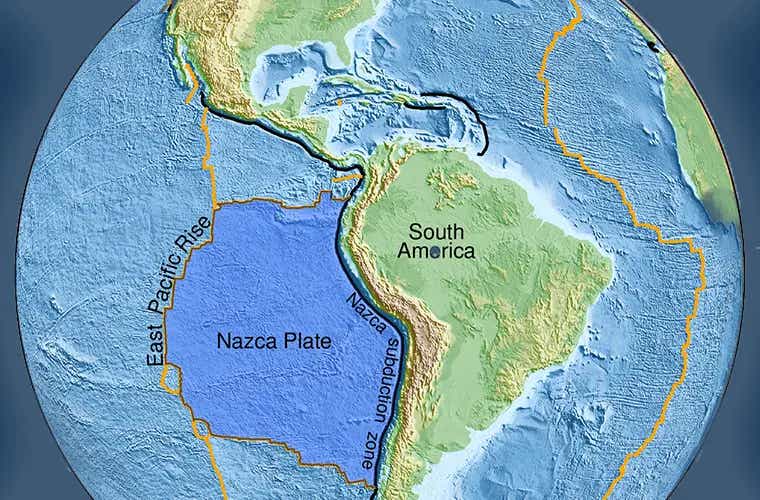Ancient seafloor discovery from the dinosaur era could rewrite Earth’s history
Scientists discover an ancient seafloor in Earth’s mantle, offering new insights into tectonic processes and Earth’s complex geological history

This discovery, made with seismic waves, suggests a complex and layered history of our planet, offering insight into processes that occurred during the age of dinosaurs. (CREDIT: Dr. Jingchuan Wang)
University of Maryland researchers have found intriguing new evidence of ancient seafloor deep beneath the Earth's surface. This discovery, made with seismic waves, suggests a complex and layered history of our planet, offering insight into processes that occurred during the age of dinosaurs. Using innovative techniques, the scientists explored a mysterious part of Earth's mantle that has remained hidden from view—until now.
The study, led by geology postdoctoral associate Jingchuan Wang, focused on the East Pacific Rise, where two segments of the planet’s crust meet in the southeastern Pacific Ocean. This previously unexamined area revealed the presence of a dense patch of seafloor that had sunk hundreds of kilometers into Earth’s interior.
The findings, published in the journal Science Advances, not only add to our understanding of plate tectonics but also challenge previous theories about the structure and behavior of Earth’s interior.
Wang's team utilized seismic imaging, a powerful tool that works like a CT scan for the Earth. Seismic waves generated by natural events like earthquakes travel through the planet, allowing scientists to map the inner structure by analyzing the way these waves move.
Working alongside geology professors Vedran Lekic and Nicholas Schmerr, Wang used this technique to peer into the mantle—a layer between Earth's crust and core. There, the researchers identified an unusually thick area in the mantle transition zone, a region lying between 410 and 660 kilometers deep. This zone separates Earth's upper and lower mantles, expanding or contracting based on temperature and pressure conditions.
The thickened area in the transition zone was unlike anything previously observed. Wang described it as "a fossilized fingerprint of an ancient piece of seafloor that subducted into the Earth approximately 250 million years ago."
Subduction is the process where one tectonic plate slides beneath another, pushing material from the Earth's surface deep into its mantle. This mechanism is crucial to understanding geological phenomena, as it often leads to earthquakes, volcanic activity, and the creation of deep ocean trenches.
Related Stories
Traditionally, subduction is studied by examining surface rock samples and sediment deposits, but this new approach offered a glimpse into the deeper consequences of this process. The team’s findings revealed that material in this section of Earth's interior was moving much more slowly than previously believed.
Wang noted that the presence of colder material in the mantle transition zone likely contributed to its unusual thickness, suggesting that oceanic slabs might become trapped midway as they descend into the mantle.
"We found that in this region, the material was sinking at about half the speed we expected," Wang explained. This surprising result indicates that the mantle transition zone might act as a barrier, slowing down the movement of subducted materials through Earth's layers. This discovery, in turn, raises questions about how the dynamics of Earth's deep interior influence surface conditions across vast distances and timescales.
The impact of these findings goes beyond mere curiosity about Earth's geological history. The team hypothesizes that the unusual split in the Pacific Low Shear Velocity Province—an area deep within the mantle known for its complex geological behavior—may be linked to the sunken seafloor they discovered.
These insights help geologists better understand how Earth's interior layers interact, and how these interactions affect tectonic activities on the surface, such as earthquakes and volcanic eruptions.
The research team plans to expand its studies to include other regions of the Pacific Ocean and beyond. By examining more areas, they hope to create a comprehensive map of ancient subduction and “upwelling” zones. Upwelling occurs when subducted material heats up and rises toward the surface, contributing to volcanic activity.
A clearer picture of these zones could deepen the understanding of how deep mantle structures interact with the surface, potentially revealing connections between past geological events and the current behavior of Earth's crust.
“We believe that there are many more ancient structures waiting to be discovered in Earth’s deep interior,” Wang said. He emphasized that each of these hidden features has the potential to offer new insights into Earth's complex history. Moreover, understanding these processes could also help in the study of other planets. “It’s giving us a glimpse into Earth’s past that we’ve never had before,” Wang added, highlighting the broader implications of their work.
This discovery emphasizes the dynamic nature of Earth's interior. While many think of the mantle as a uniform, slowly flowing layer of rock, it is much more intricate, with different materials moving at varying rates and even being recycled into new formations. The East Pacific Rise's sunken seafloor stands as a reminder of the dynamic forces shaping the planet from the inside out—a slow but powerful dance of creation and destruction that has persisted for millions of years.
Understanding Earth’s deep mantle dynamics is crucial, not only for predicting geological events but also for gaining a complete picture of the planet’s history. The work of Wang and his colleagues pushes the boundaries of current geological models, providing a more detailed and nuanced understanding of what lies beneath our feet. Their findings are a testament to how much more there is to learn about the Earth, even in regions that seem inaccessible.
In the coming years, as seismic imaging continues to improve, scientists hope to uncover more ancient secrets hidden beneath the Earth's surface. These discoveries will not only help explain our planet’s past but could also inform how we understand and prepare for future geological changes—offering insights that extend beyond Earth to other planets in our solar system.
Note: Materials provided above by The Brighter Side of News. Content may be edited for style and length.
Like these kind of feel good stories? Get The Brighter Side of News' newsletter.
Joshua Shavit
Science & Technology Writer | AI and Robotics Reporter
Joshua Shavit is a Los Angeles-based science and technology writer with a passion for exploring the breakthroughs shaping the future. As a contributor to The Brighter Side of News, he focuses on positive and transformative advancements in AI, technology, physics, engineering, robotics and space science. Joshua is currently working towards a Bachelor of Science in Business Administration at the University of California, Berkeley. He combines his academic background with a talent for storytelling, making complex scientific discoveries engaging and accessible. His work highlights the innovators behind the ideas, bringing readers closer to the people driving progress.



